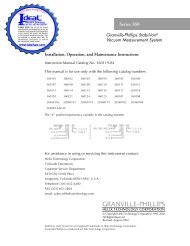Turbovac and mag - Ideal Vacuum Products
Turbovac and mag - Ideal Vacuum Products
Turbovac and mag - Ideal Vacuum Products
You also want an ePaper? Increase the reach of your titles
YUMPU automatically turns print PDFs into web optimized ePapers that Google loves.
General<br />
The turbomolecular pumps from<br />
Oerlikon Leybold <strong>Vacuum</strong> generate a<br />
clean high <strong>and</strong> ultra-high vacuum, are<br />
easy to operate <strong>and</strong> are exceptionally<br />
reliable. In connection with a well rated<br />
backing pump, pressures below<br />
10 -10 mbar (0.75 x 10 -10 Torr) can be<br />
attained.<br />
Oerlikon Leybold <strong>Vacuum</strong> offers two<br />
product lines:<br />
1. TURBOVAC line<br />
Turbomolecular pumps with<br />
mechanical rotor suspension<br />
2. TURBOVAC MAG line<br />
Turbomolecular pumps with<br />
<strong>mag</strong>netic rotor suspension<br />
Each of the two product lines contains<br />
“classic” turbomolecular pumps as<br />
well as turbomolecular pumps with a<br />
compound stage.<br />
Oerlikon Leybold <strong>Vacuum</strong> is one of the<br />
world’s leading manufacturer of turbomolecular<br />
pumps. Consequently, the<br />
TURBOVAC <strong>and</strong> the TURBOVAC MAG<br />
pumps are successfully used in many<br />
applications. A list of the most important<br />
ones is given in the table<br />
“Applications” in the section “General”.<br />
Principle of Operation<br />
The turbomolecular pump is a turbine<br />
with blades. By the momentum transfer<br />
from the rapidly rotating rotor blades<br />
to the gas molecules their initially<br />
non-directed thermal motion is changed<br />
to a directed motion.<br />
TURBOVAC SL 80 turbomolecular pump<br />
with frequency converter for attaching or separate<br />
<strong>and</strong> compound stage<br />
TURBOVAC TW 361 turbomolecular pump<br />
with mechanical rotor suspension<br />
Hence, the pumping process in a<br />
turbomolecular pump results from the<br />
directed motion of the gas molecules<br />
from the inlet flange to the forevacuum<br />
port.<br />
In the molecular flow range - i.e. at<br />
pressures below 10 -3 mbar<br />
(0.75 x 10 -3 Torr) - the mean free path<br />
of the gas molecules is larger than the<br />
spacing between rotor <strong>and</strong> stator<br />
blades (typically some tenths of a millimeter).<br />
Consequently, the molecules<br />
collide primarily with the rotor blades<br />
with the result that the pumping process<br />
is highly efficient.<br />
In the range of laminar flow, i.e. at<br />
pressures over 10 -1 mbar<br />
(0.75 x 10 -1 Torr) the situation is completely<br />
different. The effect of the rotor<br />
is impaired by the frequent collisions<br />
between the molecules. Therefore, a<br />
turbomolecular pump is not capable of<br />
pumping gases at atmospheric pressure<br />
thus necessitating the use of a suitably<br />
rated forevacuum pump.<br />
To create the directed motion of the<br />
gas molecules, the tips of the rotor<br />
blades have to move at high speeds.<br />
Hence, a high rotational speed of the<br />
rotor is required. In the case of<br />
Oerlikon Leybold <strong>Vacuum</strong> turbomolecular<br />
pumps the rotor speeds vary<br />
from about 36,000 rpm for the larger<br />
rotor diameters (e.g. TURBOVAC 1000<br />
about 20 cm (7.87 in.)) to 72,000 rpm.<br />
for small rotor diameters (e.g.<br />
TURBOVAC 50 about 6 cm (2.36 in.))<br />
TURBOVAC MAG W 1500 CT turbomolecular pump<br />
with <strong>mag</strong>netic rotor suspension <strong>and</strong><br />
compound stage<br />
Oerlikon Leybold <strong>Vacuum</strong> Full Line Catalog<br />
03<br />
C09

















